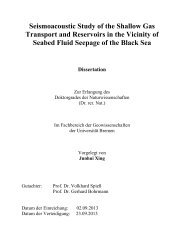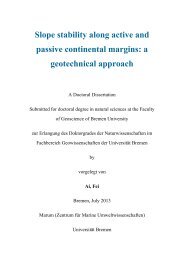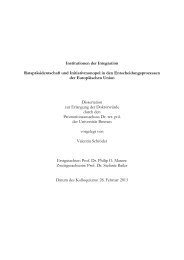aus dem MARUM und dem Fachbereich Geowissenschaften der ...
aus dem MARUM und dem Fachbereich Geowissenschaften der ...
aus dem MARUM und dem Fachbereich Geowissenschaften der ...
You also want an ePaper? Increase the reach of your titles
YUMPU automatically turns print PDFs into web optimized ePapers that Google loves.
MARIA S. MERIAN-Berichte, Cruise 20, Leg 4, Bridgetown – Freeport, 15.3.2012 – 7.4.2012<br />
h) Documentation of the sieving residue meta data within the "SaM-Archive" data base. The sieving<br />
residue itself will be stored at SaM in Wilhelmshaven, and provided on <strong>dem</strong>and for further<br />
taxonomical analyses.<br />
5.5.3 Gravity Corer<br />
A gravity corer with a pipe length of 6 or 12 m and a weight of 1.6 tons was applied to recover<br />
long sediment sequences. Imprints of the manufacturer along the plastic liners were used to retain<br />
the orientation of the core. Once on board, the sediment core was cut into 1-m-sections, closed<br />
with caps on both ends and labelled according to a standard scheme (Fig. 5.4).<br />
During MSM20-4, the gravity corer was used at 24 stations (16x equipped with 6-m- and 8x<br />
with a 12-m-long core barrel). Seventeen coring attempts were successful (70%) with sediment<br />
recoveries between 0.53 and 10.60 m resulting in total core recovery of 61.76 m. One off-mo<strong>und</strong><br />
core (GeoB 16320-2) was opened on board, described and photographed. The remaining offmo<strong>und</strong><br />
cores (GeoB 16363-3, GeoB 16384-1) and all coral-bearing sediment cores will be opened<br />
back in the institute. The latter will be scanned by computer tomography before opening. All<br />
sediment cores collected during cruise MSM20-4 will be transported to Bremen and stored in the<br />
<strong>MARUM</strong> core repository at the University of Bremen. The sediment cores will be opened,<br />
described, and photo-scanned, and further analyses will be done after the cruise at the home<br />
laboratories of the participating institutes.<br />
Fig. 5.4 The core segments were closed with caps on both ends and labelled according to a standard scheme for<br />
GeoB cores of the <strong>MARUM</strong>.<br />
5.5. <strong>MARUM</strong>-CHEROKEE ROV<br />
(ROV-Team: Nico Nowald, Götz Ruhland, Kl<strong>aus</strong> Dehning, Maik Wilsenack, Marco<br />
Klann; Observations: André Freiwald, Lydia Beuck, Claudia Wienberg, Dierk Hebbeln)<br />
The <strong>MARUM</strong>-CHEROKEE is a 1,000 m depth rated, mid-size inspection class ROV, manufactured<br />
by Sub-Atlantic, Aberdeen. It is operated by <strong>MARUM</strong> since 2001 and was adapted and improved for<br />
scientific use. The ROV has already been deployed on 24 expeditions with a total of 123 dives.<br />
System description - The ROV system consists of three major components: the vehicle, the<br />
winch, and the topside control unit.<br />
Vehicle - Vehicle dimensions are 130 x 90 x 90 cm and the total weight in air is 450 kg. The<br />
system is electrically propelled by four axial thrusters and power consumption is aro<strong>und</strong> 12 kW.<br />
Three 230 VAC dimmable LEDs, provide a total light power of 1500 W. For scientific<br />
observation, three cameras are installed on the ROV. The main camera is a Tritech Typhoon<br />
15

















